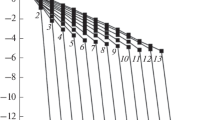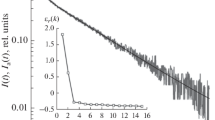A linear algorithm for analysis of the dependences of phase shift on modulation frequency measured by the frequency-domain (phase-modulation) method is discussed. The analysis is made in terms of a model consisting of a sum of exponents adapted for use in the frequency domain. The algorithm is based on linearization of the model with respect to coefficients that depend on the estimated parameters followed by application of a linear weighted least squares method. The accuracy of the resulting estimates depends on the method for determining the weighting factors that are involved. Comparative testing of the operational quality of the algorithm is carried out for several methods of calculating the weighting factors and the reasons affecting their quality are studied. A way of calculating the weighting factors is proposed that enhances the efficiency of the algorithm.
Similar content being viewed by others
Change history
09 November 2019
In the title and throughout the text, fluorescence damping should read fluorescence decay.
References
J. R. Lakowicz, Principles of Fluorescence Spectroscopy, 3rd edn., Springer US, New York (2006), pp. 158–203, 623–795.
D. V. O′Connor and D. Phillips, Time Correlated Single Photon Counting, Academic Press, London (1984), pp. 1–35.
J. N. Demas, Excited State Lifetime Measurements, Academic Press, New York (1983), pp. 1–11.
L. Marcu, Ann. Biomed. Eng., 40, No. 2, 304–331 (2012).
C. M. Vetromile and D. M. Jameson, Method. Mol. Biol., 1076, 77–96 (2014).
M. M. Yatskou, M. Meyer, S. Huber, M. Pfenniger, and G. Calzaferri, Chem. Phys. Chem., 4, 567–587 (2003).
P. J. Verveer, A. Squire, and P. I. H. Bastiaens, Methods in Cellular Imaging, Springer, New York (2001), pp. 273–294.
A. V. Digris, E. G. Novikov, V. V. Skakun, and V. V. Apanasovich, Method. Mol. Biol., 1076, 257–277 (2014).
E. G. Novikov, Rev. Sci. Instrum., 69, No. 7, 2603–2610 (1998).
E. G. Novikov, Nucl. Instr. Meth. Phys. Res. A, 423, 435–438 (1999).
A. V. Digris, E. G. Novikov, and V. V. Apanasovich, Opt. Commun., 252, 20–38 (2005).
P. R. Bevington and D. K. Robinson, Data Reduction and Error Analysis for the Physical Sciences, 3rd edn., McGraw-Hill, New York (2002), pp. 39–41.
J. R. Lakowicz, G. Laczko, H. Cherek, E. Gratton, and M. Limkeman, Biophys. J., 46, 463–477 (1984).
Author information
Authors and Affiliations
Corresponding author
Additional information
Translated from Zhurnal Prikladnoi Spektroskopii, Vol. 86, No. 4, pp. 627–633, July–August, 2019.
Rights and permissions
About this article
Cite this article
Digris, A.V., Shishkov, V.S., Novikov, E.G. et al. Influence of Weighting Factors on the Operation of a Linear Algorithm for Analysis of Data from Frequency-Domain Measurements of Fluorescence Damping Times. J Appl Spectrosc 86, 678–684 (2019). https://doi.org/10.1007/s10812-019-00878-2
Received:
Published:
Issue Date:
DOI: https://doi.org/10.1007/s10812-019-00878-2




